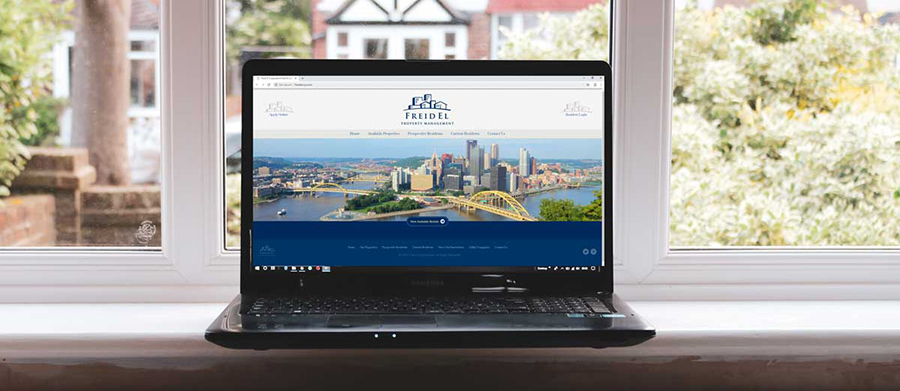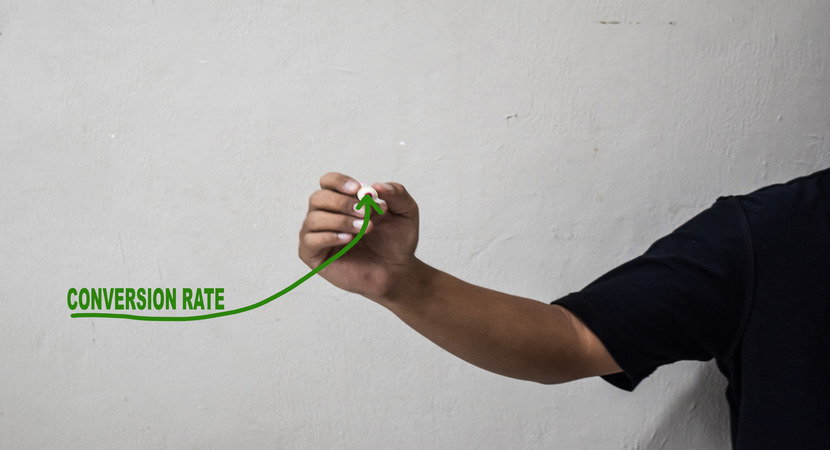This post is Part One of a Four-Part Marketing Series. This sequence of articles will dive into four key aspects of marketing your residential property management company. Whether you’re just getting started or you’re looking to take your marketing to the next level, this series will provide you with actionable insights and takeaways.
Your digital front door
When it comes to marketing for property management companies, your website is your digital front door. And the content you include on your site, the look and feel of the design, and the quality of the photos all come together to create digital curb appeal for your property. First impressions go a long way, and just like you would make sure the property and unit you were showing was prepared to make a great impression, the same story goes for your website.
According to a study by Apartments.com and Google, 72% of respondents begin their apartment search by turning to the internet. That means prospects are judging your property before ever actually seeing it in person. In today’s world, the hunt for a new home starts online.
Where do I start?
Building a property management website can seem daunting, but it doesn’t necessarily require a master web designer. Before the first line of code is written for your new site, you should start by researching your competition. Check out the websites of your top competitors—What type of layout do they use? What is their messaging? What do their photos look like? Once you know what you’re up against, begin thinking about your target audience. What types of prospects are you looking for? Picture your ideal residents and use that insight to help craft the appropriate messaging for your website.
Communicating your property’s personality
You know what you’re marketing against, and you know who you want to reach. Now it’s time to begin planning your website. The type of information you choose to include on your site is important. It’s important to include messaging that highlights the personality and brand of your property, going beyond just listing the amenities. Prospects value other key information, like an engaging description of the neighborhood the property is in, and any nearby attractions that make your community stand out. Your website should communicate the property’s value and positioning. Is your property plush and high-end? Is it affordable and comfortable? The content on your site should align with your property’s brand and match the ideal resident we mentioned earlier.
A few key must-haves on your property’s website:
#1. A picture is worth a thousand words
Photography lands at #1 on our list of must-haves, and for good reason. Renters spend 60% of their online search looking at photos. Without strong imagery, it doesn’t matter how well you describe the property in words. High-quality photography helps tell the story of your property and goes a long way in capturing the attention of your prospects. However, it’s important that the images you use represent your property honestly and authentically. You can approach photos of your properties in a variety of ways, so even if you don’t have the budget to hire a professional photographer, or to invest in your own high-end photography equipment, that’s okay.
We’ll dive deeper into how to capture better photos in Part Two of this Marketing Series.
#2. Help viewers imagine the space as their own
Beyond eye-catching photos, another item that helps build trust with your future residents is including detailed information about the physical space of the unit. Since photos can only tell part of the story, including floor plans and dimensions in your property profile will add another layer of authenticity. In fact, 87% of website traffic that continues past the homepage will go to floorplans before going to anything else. When a website includes this information, it helps prospective tenants get a better feel for the space and invites them to imagine it as their own. When renters know the dimensions of the living room, for example, they can begin to picture what living there would be like… Will their current furniture fit, or would they need to go shopping?
#3. Now available
This seems like an obvious one, yet many property websites forget to share some very essential information. Make sure you’re showing prospects the exact units available for rent. If you’re at 100% occupancy, include each unit and the dates the current leases are up. , you can automatically link vacant, rent-ready spaces to your company’s site without having to manually enter each listing. This saves you time by marketing your available units the moment they’re ready. In the same way, when a unit’s information is updated in Rent Manager—say the amenities have changed or you’ve upgraded the appliances—the change will automatically appear on your website, ensuring that you’re always sharing the most up-to-date details.
#4. Closing the loop
The prospect found your site, saw the beautiful images of your property, began planning the way their furniture would be laid out within the specific floor plan, and found the perfect unit for their next home. Now it’s time to close the loop.
The call-to-action.
The best way to speed up the process and minimize the amount of time your units are vacant is by offering online applications and guest cards. By clearly directing your prospects to apply online or fill out a guest card, you break down one more barrier between you and your next tenant. Without the clear call-to-action, a renter may like your property but continue searching for other options. Making online applications easily accessible right on the site, a potential resident will be more likely to submit their information to you. This makes the renting process more convenient for both the renter and your leasing team.
Responsive design is a must
Okay—you’ve identified all the information you’re going to put on your site. But equally as important as WHAT you put on the website, is HOW it’s presented. This means identifying a color palette that fits your brand, choosing a user-friendly layout, and—a critically important detail—making sure the site has a responsive design.
What does this mean?
A responsive website means that the site’s layout is optimized depending on the screen size of the viewer. So it doesn’t matter if a prospect is viewing from a desktop computer, their tablet, or their mobile phone, they’ll be able to interact easily with your website. Over 39% of U.S. web traffic was generated through mobile phones in 2018—that means 1/3 of your potential tenants aren’t scrolling through your site at a desktop computer. This number might be even larger when it comes to real estate and apartment hunting. According to the earlier-mentioned study by Apartments.com and Google, 50% of the respondents used their mobile phones for their apartment search.
Ready to enhance your first impression?
Web appeal is the 21st Century’s curb appeal. The digital front door to any property management company is the key to making a good first impression in the eyes of a prospect. If you need help getting started with a website, or are looking for a refresh, our talented team of web designers can create a stunning, interactive website that is fully integrated with Rent Manager.
NEW! rmWebPro is our latest product offering.
Our web development team has built a set of fully responsive
starter themes to make the process easier for you!
 Register for RMUC.25
Register for RMUC.25





